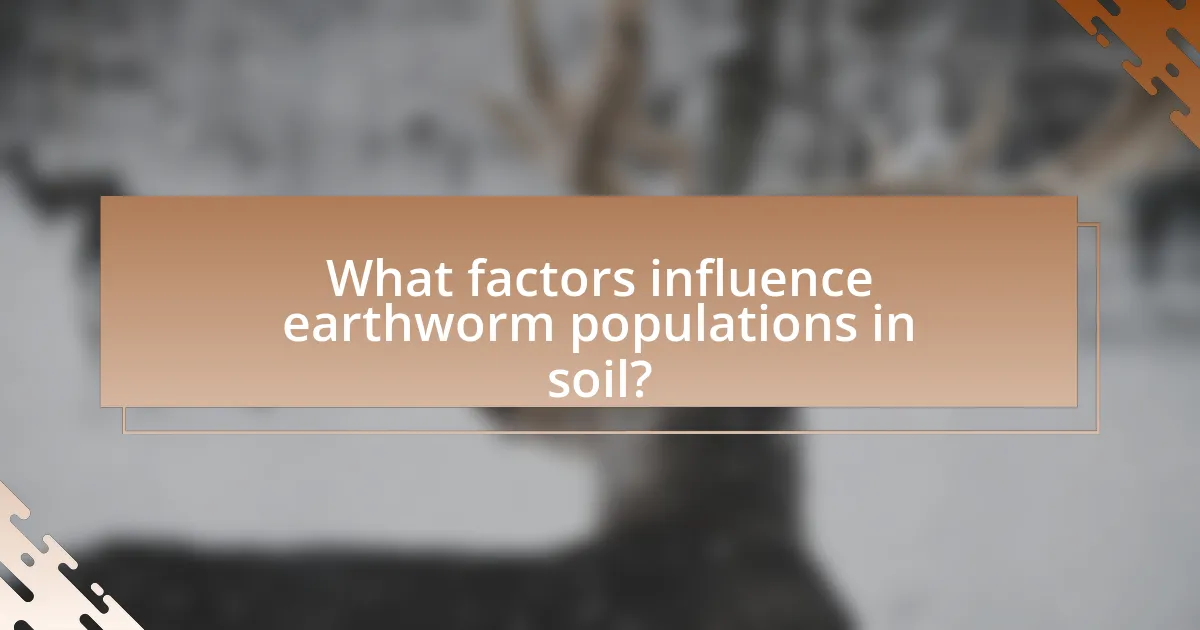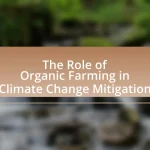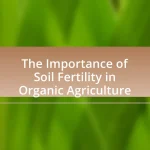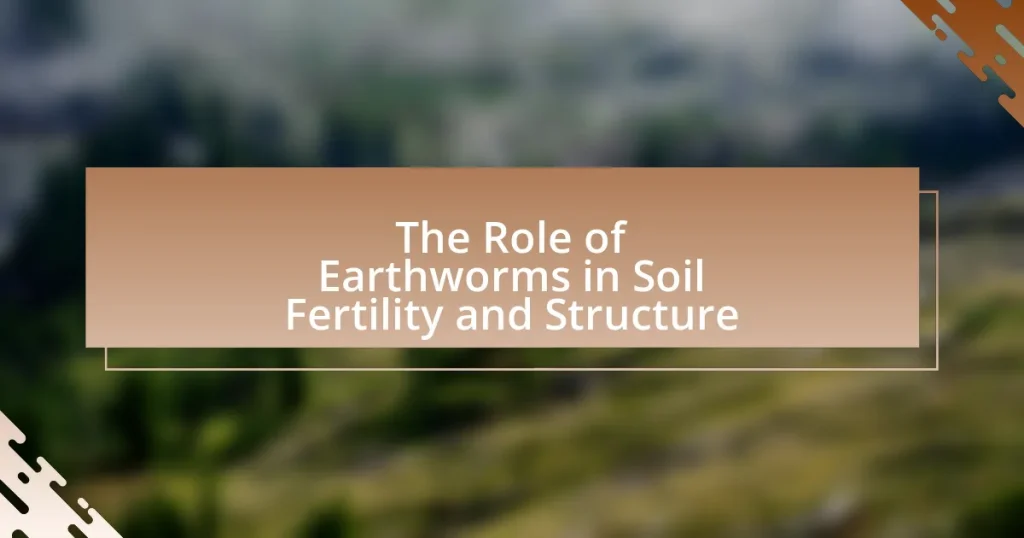Earthworms are essential organisms that significantly enhance soil fertility and structure through their natural activities. They aerate the soil, improve drainage, and facilitate nutrient cycling by consuming organic matter and excreting nutrient-rich castings. Research indicates that earthworm activity can increase soil organic matter content by up to 25%, leading to improved plant growth and soil health. Additionally, earthworms influence soil pH, promote soil aggregation, and interact with other soil organisms, making them vital for sustainable agricultural practices and ecosystem health. Factors such as soil moisture, temperature, and human activities can impact earthworm populations, highlighting the importance of practices that support their presence in soil ecosystems.

What is the role of earthworms in soil fertility and structure?
Earthworms play a crucial role in enhancing soil fertility and structure by aerating the soil, improving drainage, and facilitating nutrient cycling. Their burrowing activity creates channels that allow air and water to penetrate deeper into the soil, which promotes root growth and microbial activity. Additionally, earthworms consume organic matter, breaking it down into nutrient-rich castings that enrich the soil with essential minerals and improve its overall fertility. Studies have shown that earthworm activity can increase soil organic matter content by up to 25%, significantly benefiting plant growth and soil health.
How do earthworms contribute to soil fertility?
Earthworms enhance soil fertility by breaking down organic matter and facilitating nutrient cycling. As they consume decaying plant material, earthworms excrete nutrient-rich castings that improve soil structure and increase the availability of essential nutrients like nitrogen, phosphorus, and potassium. Research indicates that earthworm activity can increase soil organic matter content by up to 25%, which directly correlates with improved soil fertility and plant growth. Their burrowing also aerates the soil, promoting better water infiltration and root development, further contributing to a fertile environment for plants.
What processes do earthworms use to enhance nutrient availability?
Earthworms enhance nutrient availability through processes such as organic matter decomposition, soil aeration, and nutrient cycling. By consuming organic matter, earthworms break it down into simpler compounds, which increases the availability of nutrients like nitrogen and phosphorus in the soil. Their burrowing activity aerates the soil, improving water infiltration and root growth, which further facilitates nutrient uptake by plants. Additionally, earthworms excrete nutrient-rich castings that contain higher concentrations of essential nutrients compared to the surrounding soil, thereby enriching the soil ecosystem. Studies have shown that earthworm activity can increase soil fertility significantly, with some research indicating that their presence can enhance crop yields by up to 25%.
How do earthworms affect soil pH and organic matter content?
Earthworms significantly influence soil pH and organic matter content by enhancing soil structure and promoting microbial activity. Their burrowing actions aerate the soil, which facilitates the decomposition of organic matter and the release of nutrients. Research indicates that earthworm activity can lead to a decrease in soil pH, making it more acidic, which can enhance nutrient availability for plants. Additionally, earthworms contribute to the accumulation of organic matter through their castings, which are rich in nutrients and improve soil fertility. Studies have shown that earthworm populations correlate with increased organic matter levels, demonstrating their vital role in maintaining soil health and fertility.
What impact do earthworms have on soil structure?
Earthworms significantly enhance soil structure by creating channels and burrows that improve aeration and drainage. Their burrowing activity loosens compacted soil, allowing roots to penetrate more easily and facilitating the movement of water and nutrients. Additionally, earthworms contribute organic matter through their castings, which increases soil aggregation and stability. Research indicates that earthworm activity can increase soil porosity by up to 30%, leading to improved water retention and root growth.
How do earthworms influence soil aeration and drainage?
Earthworms significantly enhance soil aeration and drainage by creating burrows as they move through the soil. These burrows allow air to penetrate deeper into the soil profile, facilitating gas exchange and improving root respiration. Additionally, the tunnels created by earthworms increase water infiltration rates, reducing surface runoff and promoting better drainage. Research indicates that earthworm activity can increase soil porosity by up to 30%, which directly contributes to improved aeration and drainage capabilities in various soil types.
What role do earthworms play in soil aggregation?
Earthworms play a crucial role in soil aggregation by enhancing the formation of stable soil aggregates through their burrowing and feeding activities. As earthworms move through the soil, they create channels that improve aeration and water infiltration, which facilitates the binding of soil particles. Additionally, earthworms excrete mucus and organic matter, which act as natural glues, promoting the cohesion of soil particles into aggregates. Research has shown that earthworm activity can increase soil aggregate stability, leading to improved soil structure and fertility, as evidenced by studies indicating that soils with higher earthworm populations exhibit greater aggregate stability and nutrient retention.

Why are earthworms considered ecosystem engineers?
Earthworms are considered ecosystem engineers because they significantly modify soil structure and nutrient availability through their burrowing and feeding activities. Their burrowing aerates the soil, enhances water infiltration, and promotes root growth, which improves plant health and productivity. Additionally, earthworms break down organic matter, facilitating nutrient cycling and increasing soil fertility. Studies have shown that earthworm activity can increase soil porosity by up to 50%, leading to improved soil health and ecosystem resilience.
How do earthworms modify their environment?
Earthworms modify their environment primarily through the process of bioturbation, which involves the mixing and aeration of soil. By burrowing through the soil, earthworms create channels that enhance water infiltration and root penetration, improving soil structure. Their excretions, known as castings, enrich the soil with nutrients, increasing its fertility. Research indicates that earthworm activity can increase soil porosity by up to 30%, facilitating better drainage and aeration, which are crucial for plant growth.
What are the physical changes earthworms create in the soil?
Earthworms create several physical changes in the soil, including the aeration of soil, the formation of soil aggregates, and the enhancement of drainage. By burrowing through the soil, earthworms increase porosity, allowing air and water to penetrate more effectively, which is crucial for plant root development. Their movement also leads to the mixing of organic matter and minerals, promoting the formation of stable soil aggregates that improve soil structure. Additionally, the channels created by earthworm burrows facilitate better drainage, reducing waterlogging and enhancing soil moisture retention. These changes contribute significantly to soil fertility and overall ecosystem health.
How do earthworms interact with other soil organisms?
Earthworms interact with other soil organisms primarily through their activities of burrowing, feeding, and excreting organic matter. These actions facilitate the aeration of soil, enhance nutrient cycling, and promote microbial activity. For instance, earthworm castings are rich in nutrients and serve as a food source for various microorganisms, thereby increasing soil fertility. Additionally, earthworms help decompose organic matter, which benefits fungi and bacteria that thrive in the enriched environment. Research indicates that earthworm activity can increase microbial biomass by up to 50%, demonstrating their significant role in enhancing soil health and structure.
What are the ecological benefits of earthworms in agriculture?
Earthworms provide significant ecological benefits in agriculture by enhancing soil fertility and structure. They improve soil aeration and drainage through their burrowing activities, which facilitates root growth and water infiltration. Additionally, earthworms contribute to nutrient cycling by breaking down organic matter, leading to the production of nutrient-rich castings that enhance soil fertility. Research indicates that earthworm activity can increase soil organic carbon levels, which is crucial for maintaining soil health and productivity. Studies have shown that fields with higher earthworm populations often exhibit improved crop yields, demonstrating their vital role in sustainable agricultural practices.
How do earthworms contribute to sustainable farming practices?
Earthworms contribute to sustainable farming practices by enhancing soil fertility and structure through their natural processes. They aerate the soil, allowing for better water infiltration and root growth, which improves plant health. Additionally, earthworms break down organic matter, converting it into nutrient-rich castings that serve as a natural fertilizer. Research indicates that earthworm activity can increase soil organic carbon levels by up to 25%, which is crucial for maintaining soil health and productivity. Their burrowing also promotes microbial activity, further enriching the soil ecosystem, making earthworms essential for sustainable agricultural practices.
What are the economic advantages of promoting earthworm populations?
Promoting earthworm populations offers significant economic advantages, primarily through enhanced soil fertility and improved agricultural productivity. Earthworms contribute to soil aeration, nutrient cycling, and organic matter decomposition, which leads to healthier crops and higher yields. For instance, studies have shown that fields with higher earthworm populations can yield up to 25% more produce compared to those with fewer earthworms, translating to increased revenue for farmers. Additionally, the presence of earthworms reduces the need for chemical fertilizers, resulting in cost savings and lower environmental impact. This dual benefit of increased crop yield and reduced input costs underscores the economic value of fostering earthworm populations in agricultural systems.

What factors influence earthworm populations in soil?
Earthworm populations in soil are influenced by factors such as soil moisture, temperature, organic matter availability, and soil pH. Soil moisture is critical because earthworms require a moist environment for respiration and movement; studies show that optimal moisture levels can significantly enhance their populations. Temperature affects their activity and reproduction rates, with earthworms thriving in moderate temperatures typically between 10°C and 25°C. The availability of organic matter, such as decomposing leaves and plant material, serves as a food source, directly impacting their growth and reproduction. Additionally, soil pH influences earthworm survival, with neutral to slightly acidic conditions (pH 6-7) being most favorable for their populations. These factors collectively determine the abundance and health of earthworm communities in various soil ecosystems.
How does soil type affect earthworm diversity?
Soil type significantly affects earthworm diversity by influencing habitat suitability, food availability, and moisture levels. Different soil textures, such as sandy, clayey, or loamy soils, provide varying conditions for earthworm species. For instance, loamy soils, which have a balanced mixture of sand, silt, and clay, typically support a higher diversity of earthworms due to their optimal drainage and nutrient content. Research indicates that earthworm populations are often more abundant in soils rich in organic matter, as these conditions enhance food sources and moisture retention, which are critical for earthworm survival and reproduction. Studies have shown that specific earthworm species are adapted to particular soil types, leading to distinct communities in different environments, thereby demonstrating the direct correlation between soil characteristics and earthworm diversity.
What are the preferred habitats for different earthworm species?
Different earthworm species prefer various habitats based on their ecological roles and adaptations. For instance, Lumbricus terrestris, commonly known as the common earthworm, thrives in moist, rich soils found in gardens and agricultural fields, where organic matter is abundant. In contrast, Aporrectodea caliginosa, or the grey worm, prefers wetter environments such as marshes and floodplains, as it is adapted to saturated soils. Additionally, Eisenia fetida, known as the red wiggler, is often found in compost heaps and decaying organic matter, making it ideal for vermiculture. These habitat preferences are supported by their physiological adaptations, such as moisture retention and organic matter processing capabilities, which enhance soil fertility and structure.
How do soil moisture and temperature impact earthworm activity?
Soil moisture and temperature significantly influence earthworm activity, with optimal conditions enhancing their movement and reproduction. Earthworms thrive in moist environments, as adequate soil moisture facilitates their physiological processes and aids in burrowing. Research indicates that earthworm activity peaks at temperatures between 15°C and 25°C, with extreme temperatures leading to reduced activity or dormancy. For instance, a study published in the journal “Soil Biology and Biochemistry” by Edwards and Bohlen (1996) found that earthworm populations are highest in soils with moisture levels between 20% and 40%, demonstrating a clear correlation between moisture, temperature, and earthworm behavior.
What human activities threaten earthworm populations?
Human activities that threaten earthworm populations include agricultural practices, urbanization, and pollution. Intensive farming methods, such as the excessive use of pesticides and fertilizers, disrupt soil health and reduce earthworm habitats. Urbanization leads to habitat loss as land is developed for infrastructure, while pollution from chemicals and waste can contaminate soil, making it inhospitable for earthworms. Studies have shown that these factors significantly decrease earthworm diversity and abundance, which in turn affects soil fertility and structure.
How does pesticide use affect earthworm health?
Pesticide use negatively affects earthworm health by causing mortality and reducing reproductive success. Studies have shown that exposure to various pesticides, such as organophosphates and neonicotinoids, can lead to decreased earthworm populations and impaired physiological functions. For instance, research published in the journal “Ecotoxicology” found that earthworms exposed to neonicotinoids exhibited significant mortality rates and reduced growth, indicating a direct link between pesticide exposure and earthworm health. Additionally, pesticides can disrupt the soil ecosystem, further diminishing the role of earthworms in maintaining soil fertility and structure.
What role does soil degradation play in earthworm decline?
Soil degradation significantly contributes to earthworm decline by disrupting their habitat and reducing soil quality. Degraded soils often exhibit lower organic matter content, which is essential for earthworm survival, as they rely on organic material for food. Additionally, soil compaction and erosion, common in degraded environments, hinder earthworm movement and reproduction. Research indicates that areas with high soil degradation can experience a reduction in earthworm populations by up to 50%, highlighting the direct correlation between soil health and earthworm viability.
What practices can enhance earthworm populations in soil?
Practices that can enhance earthworm populations in soil include maintaining organic matter, reducing soil disturbance, and implementing crop rotation. Organic matter, such as compost and mulch, provides essential food for earthworms, promoting their growth and reproduction. Reducing soil disturbance through minimal tillage preserves earthworm habitats and prevents the disruption of their burrows. Crop rotation introduces diverse plant roots, which can improve soil structure and provide varied food sources for earthworms. Research indicates that soils with higher organic matter content can support up to 10 times more earthworm biomass, demonstrating the effectiveness of these practices in enhancing earthworm populations.
How can organic farming methods support earthworm health?
Organic farming methods support earthworm health by enhancing soil quality and biodiversity. Practices such as crop rotation, cover cropping, and the use of organic fertilizers improve soil structure and increase organic matter, which provides a habitat and food source for earthworms. Research indicates that organic farming can lead to higher earthworm populations compared to conventional farming, as shown in a study published in the journal “Soil Biology and Biochemistry,” where organic fields had up to 50% more earthworms due to improved soil conditions and reduced chemical exposure.
What are the best practices for maintaining healthy soil ecosystems?
The best practices for maintaining healthy soil ecosystems include promoting biodiversity, minimizing soil disturbance, and implementing organic matter management. Biodiversity enhances soil resilience and fertility; for instance, diverse plant roots can improve soil structure and nutrient cycling. Minimizing soil disturbance, such as through reduced tillage, preserves soil structure and microbial communities, which are vital for nutrient availability. Organic matter management, including the addition of compost or cover crops, enriches soil with nutrients and improves water retention. Research indicates that these practices can significantly enhance soil health, as evidenced by studies showing that organic farming methods lead to increased soil organic carbon levels and improved soil structure.










